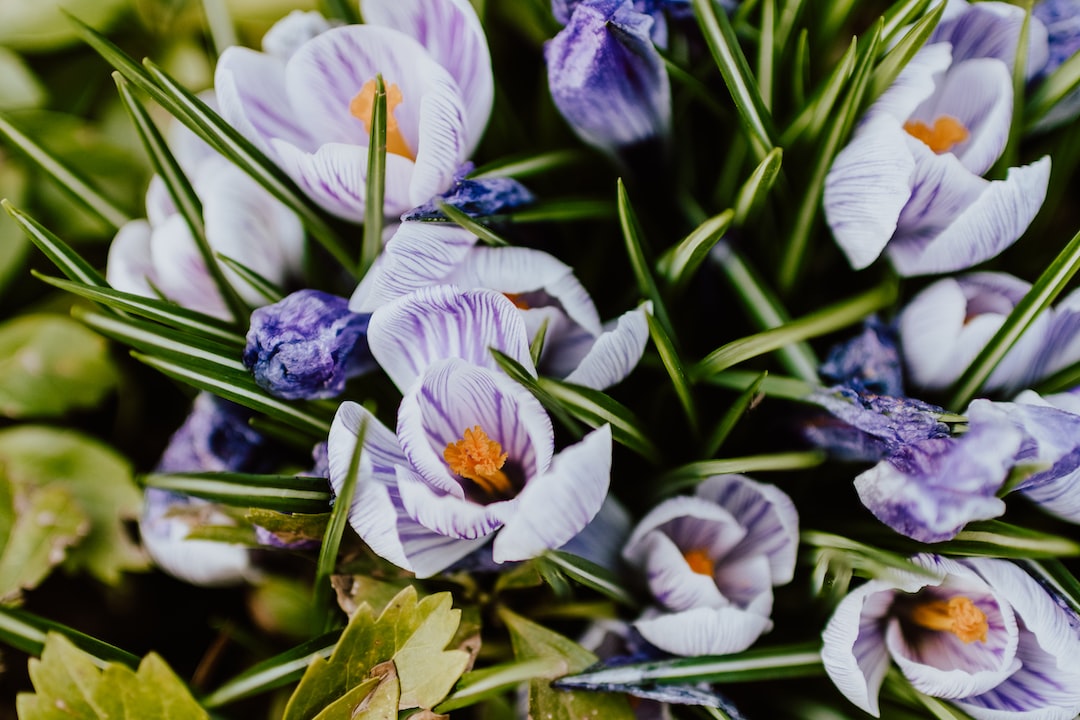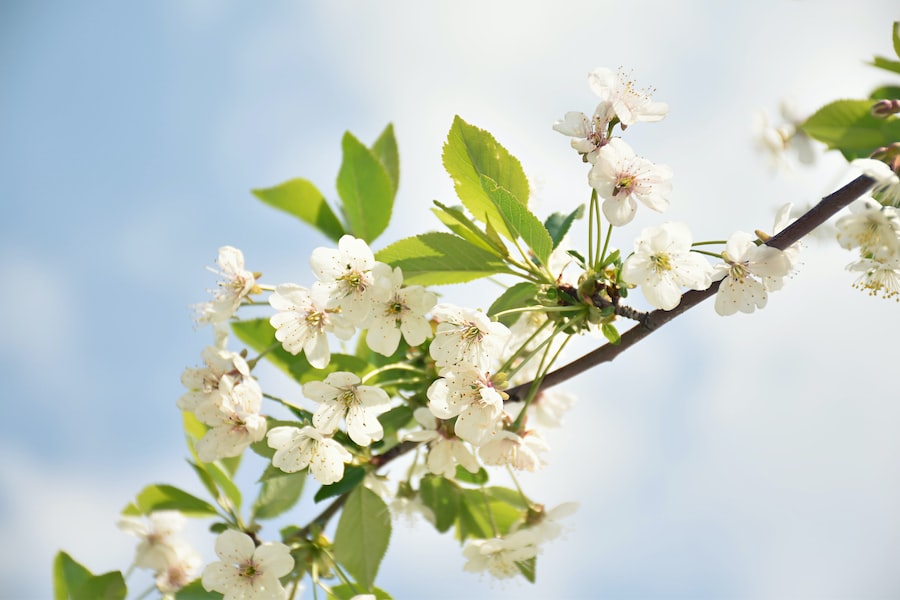Unlocking the Secret to Blooming Peace Lilies: A Guide to Growing Stunning Flowers

Peace lilies, also known as Spathiphyllum, are popular houseplants that are loved for their beautiful white flowers and lush green foliage. These plants are native to the tropical regions of Central and South America and have been cultivated for centuries. The peace lily gets its name from the white flowers that resemble a white flag of surrender, symbolizing peace.
Peace lilies are known for their air-purifying qualities, making them a great addition to any indoor space. They have the ability to remove harmful toxins from the air, such as formaldehyde, benzene, and carbon monoxide. This makes them an excellent choice for homes and offices where air quality may be a concern.
Key Takeaways
- Peace lilies are popular houseplants that are easy to care for and can thrive in low-light conditions.
- Choosing the right soil is important for the health of your peace lilies, as they prefer well-draining soil that is rich in organic matter.
- Overwatering can be a common mistake when caring for peace lilies, so it’s important to let the soil dry out slightly between waterings.
- Peace lilies prefer bright, indirect light and can suffer if exposed to direct sunlight or low-light conditions for extended periods of time.
- Fertilizing your peace lilies every 2-3 months with a balanced fertilizer can help promote healthy growth and flowering.
Choosing the Right Soil for Your Peace Lilies
Choosing the right soil is crucial for the health and growth of your peace lilies. These plants prefer a well-draining soil that retains moisture without becoming waterlogged. A good potting mix for peace lilies should be rich in organic matter and have good drainage properties.
There are several types of soil that are suitable for peace lilies. One option is a peat-based potting mix, which is lightweight and retains moisture well. Another option is a mixture of equal parts peat moss, perlite, and vermiculite, which provides good drainage while retaining moisture.
Before planting your peace lilies, it’s important to prepare the soil properly. Start by filling the pot with the chosen potting mix, leaving enough space at the top for watering. Gently remove the plant from its nursery pot and place it in the center of the pot. Fill in any gaps with additional potting mix, making sure not to bury the crown of the plant.
Watering Your Peace Lilies: Dos and Don’ts
Proper watering is essential for the health of your peace lilies. These plants prefer to be kept evenly moist, but they don’t like to sit in water. Overwatering can lead to root rot, while underwatering can cause the leaves to wilt and turn yellow.
To water your peace lilies, wait until the top inch of soil feels dry to the touch before watering. When watering, make sure to thoroughly saturate the soil until water drains out of the bottom of the pot. Empty any excess water from the saucer to prevent waterlogging.
One common mistake when watering peace lilies is using cold water. These plants prefer lukewarm water, as cold water can shock their roots and cause damage. Another mistake is overwatering, which can lead to root rot. It’s important to find the right balance and avoid both underwatering and overwatering.
Lighting Requirements for Growing Healthy Peace Lilies
| Lighting Requirement | Measurement |
|---|---|
| Light Intensity | 1500-2500 lux |
| Light Duration | 12-14 hours per day |
| Light Spectrum | Full spectrum or cool white fluorescent bulbs |
| Light Distance | 6-12 inches from plant |
Peace lilies thrive in bright, indirect light. They prefer bright, filtered light rather than direct sunlight, as direct sunlight can scorch their leaves. Placing your peace lilies near a north or east-facing window is ideal, as these locations provide bright but indirect light.
If you don’t have access to a window with bright, indirect light, you can also grow peace lilies under fluorescent lights. Place the lights about 12 inches above the plants and keep them on for 12-14 hours a day.
Signs of insufficient light exposure include pale or yellowing leaves and lack of flowering. On the other hand, signs of excessive light exposure include brown spots on the leaves and leaf burn. If you notice any of these signs, adjust the lighting conditions accordingly.
Fertilizing Your Peace Lilies: Tips and Tricks
Fertilizing is important for promoting healthy growth and flowering in peace lilies. These plants benefit from regular feeding during the growing season, which is typically spring and summer. A balanced, water-soluble fertilizer with equal amounts of nitrogen, phosphorus, and potassium is suitable for peace lilies.
To fertilize your peace lilies, dilute the fertilizer according to the package instructions and apply it to the soil once a month. Make sure to water the plant before and after fertilizing to prevent root burn. It’s also important not to over-fertilize, as this can lead to salt buildup in the soil.
In addition to regular fertilizing, peace lilies can also benefit from occasional foliar feeding. This involves spraying a diluted fertilizer solution directly onto the leaves. This can help provide nutrients directly to the plant and promote healthy growth.
Repotting Peace Lilies: When and How to Do It

Peace lilies generally don’t require frequent repotting, but they may need to be repotted every 1-2 years as they outgrow their current pot. Signs that your peace lilies need repotting include roots growing out of the drainage holes, stunted growth, or the plant becoming top-heavy.
To repot your peace lilies, choose a pot that is one size larger than their current pot. Fill the new pot with fresh potting mix and gently remove the plant from its current pot. Loosen the roots and place the plant in the center of the new pot. Fill in any gaps with additional potting mix and water thoroughly.
During repotting, it’s important to be gentle with the roots to avoid damaging them. If you notice any damaged or rotting roots, trim them off with clean scissors before repotting. This will help promote healthy root growth and prevent any potential issues.
Common Pests and Diseases That Affect Peace Lilies
While peace lilies are generally hardy plants, they can still be susceptible to certain pests and diseases. Some common pests that can affect peace lilies include spider mites, mealybugs, and aphids. These pests can be controlled by regularly inspecting the plant for signs of infestation and treating them with insecticidal soap or neem oil.
In terms of diseases, peace lilies can be prone to root rot if they are overwatered or if the soil doesn’t have good drainage. To prevent root rot, make sure to water your peace lilies properly and provide them with well-draining soil. If you notice any signs of root rot, such as yellowing leaves or a foul smell, it’s important to take action immediately.
Propagating Peace Lilies: Simple Techniques to Try
Propagating peace lilies is a fun and rewarding way to expand your collection or share plants with friends and family. There are several methods you can use to propagate peace lilies, including division, leaf cuttings, and stem cuttings.
To propagate peace lilies by division, start by removing the plant from its pot and gently separating the roots into smaller sections. Each section should have at least one healthy leaf and a portion of the root system. Plant each division in its own pot with fresh potting mix and water thoroughly.
Leaf cuttings can also be used to propagate peace lilies. Simply cut a healthy leaf from the plant and place it in a container filled with water. Make sure that at least half of the leaf is submerged in water. After a few weeks, roots should start to develop, and you can transfer the cutting to a pot with potting mix.
Stem cuttings are another option for propagating peace lilies. Take a stem cutting with at least two nodes and remove any leaves from the lower portion of the stem. Place the cutting in a container filled with water and wait for roots to develop. Once roots have formed, transfer the cutting to a pot with potting mix.
Decorating with Peace Lilies: Creative Ideas for Your Home
Peace lilies are not only beautiful and beneficial for air quality, but they can also be used as decorative elements in your home. There are many creative ways to incorporate peace lilies into your home decor.
One idea is to place peace lilies in decorative pots or planters and use them as centerpieces on dining tables or coffee tables. You can also hang peace lilies in macrame plant hangers or place them on floating shelves to add a touch of greenery to your walls.
In addition to traditional pots, you can also display peace lilies in glass vases or terrariums. This allows you to see the roots and create a unique and eye-catching display. Another idea is to group several peace lilies together in different sizes and heights to create a visually interesting arrangement.
Troubleshooting Peace Lily Problems: How to Fix Common Issues
Despite their hardiness, peace lilies can still experience issues from time to time. Some common problems that you may encounter include yellowing leaves, brown tips, and lack of flowering.
Yellowing leaves can be caused by overwatering, underwatering, or insufficient light. To fix this issue, make sure you are watering your peace lilies properly and providing them with adequate light. If the leaves are turning yellow from the bottom up, it may be a sign of root rot, in which case you should check the roots for any signs of damage.
Brown tips on the leaves are usually a sign of low humidity or over-fertilizing. To fix this issue, increase the humidity around your peace lilies by placing a tray of water near them or using a humidifier. If you suspect over-fertilizing, reduce the amount of fertilizer you are using and make sure to flush the soil with water to remove any excess salts.
If your peace lilies are not flowering, it may be due to insufficient light or lack of nutrients. Make sure your peace lilies are receiving enough bright, indirect light and fertilize them regularly during the growing season. It’s also important to note that peace lilies may take some time to establish before they start flowering, so be patient.
Conclusion:
Growing healthy and beautiful peace lilies is not as difficult as it may seem. By understanding the basics of peace lily care, such as choosing the right soil, watering properly, providing adequate lighting, fertilizing regularly, and troubleshooting common issues, you can enjoy the benefits of these stunning plants in your home.
Peace lilies not only add beauty to any space with their elegant white flowers and lush green foliage, but they also help purify the air by removing harmful toxins. They are a great choice for anyone looking to improve indoor air quality and create a peaceful and serene environment.
So go ahead and bring some peace lilies into your home. With a little care and attention, these plants will thrive and bring beauty and tranquility to your space.
If you’re struggling to get your peace lily to bloom, you’re not alone. Many plant enthusiasts face this challenge. However, there are effective techniques you can try to encourage your peace lily to produce beautiful blooms. One helpful resource is an article titled “How to Get Your Peace Lily to Bloom” from Lawn World’s website. This article provides valuable tips and insights on creating the ideal conditions for your peace lily to thrive and bloom. Check it out here for expert advice on bringing out the best in your peace lily.



